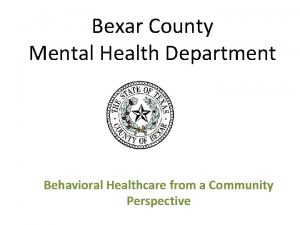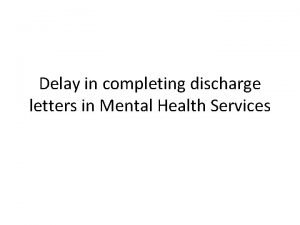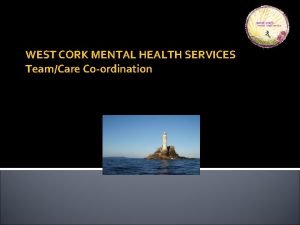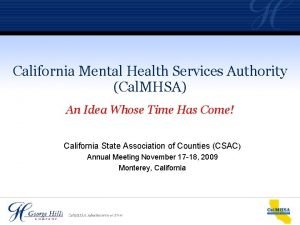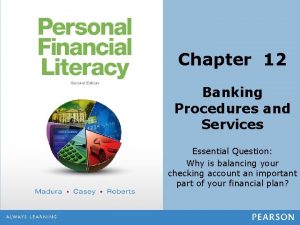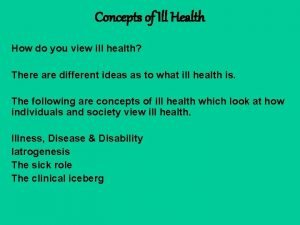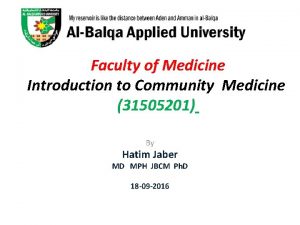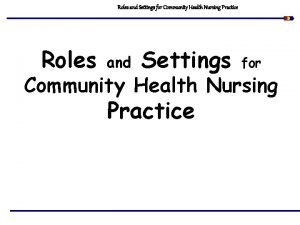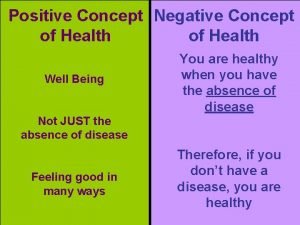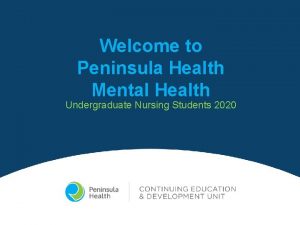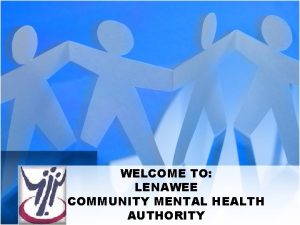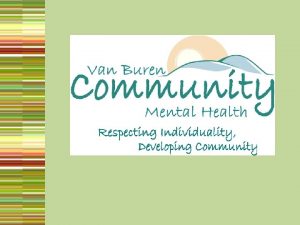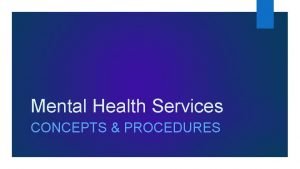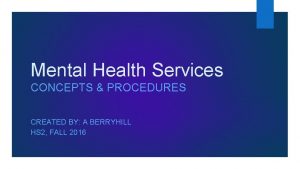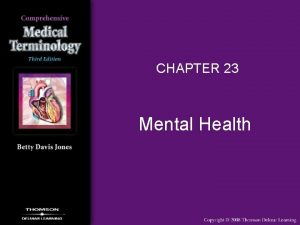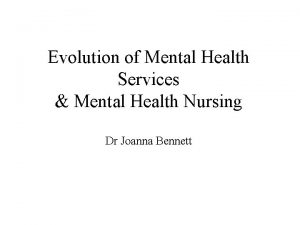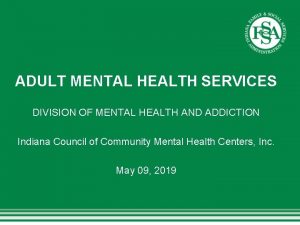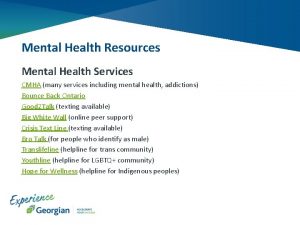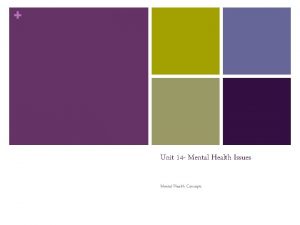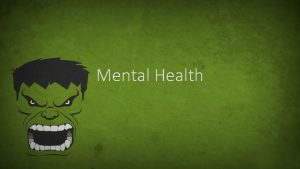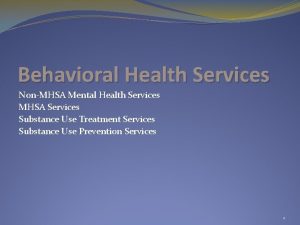Mental Health Services CONCEPTS PROCEDURES Concepts Procedures Mental




















- Slides: 20

Mental Health Services CONCEPTS & PROCEDURES

Concepts & Procedures Mental health concepts & Psychoneurosis (Phobia) procedures we will discuss: Suicide prevention Therapeutic communication Forms of therapy Physical restraints Chemical restraints Reality orientation Psychosis (Bipolar)

Therapeutic Communication Process in which the nurse consciously influences a pt or helps the pt to a better understanding through verbal or nonverbal communication It involves the use of specific strategies that encourage the pt to express feelings and ideas and that convey acceptance and respect Many different techniques (we will learn 8) (10 min) https: //www. youtube. com/watch? v=s 4 xb. G 2 LSDWw&ebc=ANy. Px. Krlui. W 2 Yf. FZOZC 1 V 5 VIEnon_2 KMahrr. JTY 3 8 a. PNr. E 9 hm. A 5 L 381 B 52 Gr. Wb-EXROh. EZ 4 Fu. Up. Ro. C 006 K_GS 6 -ac 6 PJwkws 9 g

Therapeutic Communication Techniques: Using silence=allows client to take control of the discussion, if he or she so desires (The client says: "We drink and smoke a lot here. " The student thinks…how can that be…drinking alcohol in a state hospital? But says nothing…using silence…the client then says: "yes we drink a lot of cokes and smoke a lot. “) Accepting=conveys positive regard ("Yes" or "I follow what you said" ) Giving recognition=acknowledging, indicating awareness ("I notice you combed your hair. “) Offering self=making oneself available ("I'll sit with you awhile. “)

Therapeutic Communication Techniques: Using General Leads=using neutral expressions to encourage continued talking by the pt ("Go on. " Ummm. . I am listening" "Tell me about it“) Using Broad Opening=allows client to select the topic ("What would you like to talk about? “) Placing he event in time or sequence=clarifies the relationship of events in time ("Was this before or after…? “) Reflecting=directs questions or feelings back to client so that they may be recognized and accepted (Patient: "Do you think I should tell the doctor? " Nurse: "Do you think you should tell the doctor? "

Restraints Restraints=anything that impedes a pt’s movement May be physical or chemical Restraints must be used sparingly & only when MD orders them Pt’s rights include the right to be free from restraints & abuse and to participate in activities-restraints can violate these

Physical Restraints Used to protect the pt or others from harm (prevent pt from falling OOB, falling while walking, scratching at wounds, pulling out IV’s, harming themselves or others) Should never be used as a punishment for behavior or for caregiver’s convenience Bedside rails can be considered restraints, use quarter side rails when appropriate Before restraining pt, all other methods of ensuring pt’s safety must be attempted (moving close to nurse’s station, 1: 1 observation) (1: 45) https: //www. youtube. com/watch? v=DDXNDdxbi. WM

Physical Restraints Safety rules: Use right size and type of restraint Ensure pt is in comfortable position after restraint is applied Check circulation below the restraint-notify supervisor with any problems (coolness, cyanosis) 2 fingers should be able to slide between the wrist/ankle & restraint Make sure pt can move the part that is restrained Make sure pt’s needs are taken care of while they are restrained

Physical Restraints Safety rules: Restraints must be loosened or taken off at least q 2 h Never tie restraint to side rail Use quick-release tie Never leave pt unattended or turn your back when restraints are temporarily removed Document all info concerning restraints

Chemical Restraints AKA medications used to calm pts who are agitated or anxious Physician must prescribe the medication Check the ID bracelet before administering Don’t leave the med at the bedside or assume the pt has swallowed it

Reality Orientation Pts with mental health disorders can become confused Some are unable to focus on what they are doing They can become lost & wander or not follow directions Older pts can become confused due to Alzheimer’s, depression, illness, pain, dehydration, or new surroundings Reality orientation=helping pts to become aware of his or her surroundings, the date & time, & other pertinent info about their present situation Calendars, color-coding areas, & clocks can assist with reality orient.

Suicide Prevention (3: 47) https: //www. youtube. com/watch? v=3 BByqa 7 bhto Reach Out - Ask them directly if they are thinking about suicide. It needs to be a direct question that can’t be misinterpreted. "Are you thinking about suicide? " Most people with thoughts of suicide want to talk about it. They want to live – but desperately need someone to hear their pain and offer them help to keep safe. Don’t be afraid to ask them if they are thinking about suicide. This shows you care and they’re not alone.

Suicide Prevention Listen to them - Allow them to express their feelings. Let them do most of the talking. They will often feel a great sense of relief someone wants to talk to them about their darkest thoughts. Check their safety - If you are really worried don’t leave them alone. Remove any means of suicide including weapons, medications, drugs, alcohol, even access to a car. Get help by calling 911. You can also take them to the local hospital emergency department.

Suicide Prevention Decide what to do and take action - Talk about steps you can take together to keep them safe. Don’t agree to keep it a secret, you shouldn’t be the only one supporting this person. Ask for a promise - Thoughts of suicide may return, so ask them to promise to reach out and tell someone. Asking them to promise makes it more likely they will tell someone.

Suicide Prevention Get help - There are lots of services and people that can help and provide assistance. (doctor, Counsellor, psychologist, social worker, School Counsellor , Community Health Centers, Seek support from family and friends, youth group leader, sports coach, priest, minister or religious leader etc. ) In some situations they may refuse help and you can’t force them to get help. You need to ensure the appropriate people are aware of the situation. Don’t shoulder this responsibility yourself.

Forms of Therapy Cognitive Behavioral Therapy-helps pt learn to recognize negative patterns of thought, evaluate their validity, & replace them with healthier ways of thinking (4: 35) https: //www. youtube. com/watch? v=b. UOa. Hsxe 8 OQ Dialectical Behavior Therapy-therapist assures pt that their behavior & feelings are valid & understandable. Therapist coaches pt to understand that it is his or her personal responsibility to change unhealthy or disruptive behavior

Forms of Therapy Interpersonal Therapy-most often used on a one-on-one basis to treat depression; based on the idea that improving communication patterns & the ways people relate to others will effectively treat depression Family-focused Therapy-includes family members in therapy sessions to improve family relationships, which may support better treatment results Play Therapy-used with children, involves the use of toys and games to help a child identify and talk about his or her feelings, as well as establish communication with a therapist.

Psychosis Psychotic disorders are severe mental disorders that cause abnormal thinking and perceptions. People with psychosis lose touch with reality. Two of the main symptoms are delusions and hallucinations. Delusions are false beliefs, such as thinking that someone is plotting against you or that the TV is sending you secret messages Hallucinations are false perceptions, such as hearing, seeing, or feeling something that is not there (3: 01) https: //www. youtube. com/watch? v=_v. YQ 6 pb. Jt 2 k

Psychosis Treatment - depends on the cause of the psychosis. It might involve drugs to control symptoms and talk therapy. Hospitalization is an option for serious cases where a person might be dangerous to himself or others. Bipolar Disorder & schizophrenia are psychotic disorders Bipolar, AKA manic-depressive illness, causes unusual shifts in mood, energy, activity levels, and the ability to carry out day-to-day tasks.

Psychoneurosis Psycho-neurotic disorders - refers to a class of mental disorders involving distress but not delusions or hallucinations (phobias & anxiety disorders) (11: 31) https: //www. youtube. com/watch? v=a. X 7 jn. VXXG 5 o Symptoms = anxiety and fear are common symptoms Treatment = varies depending on severity of the condition Psychoneurotic disorders can negatively affect a person's ability to function effectively in ADL’s, such as going to work and school, caring for family, and taking care of basic needs.
 Chapter 20 mental health and mental illness
Chapter 20 mental health and mental illness Jeopardy mental health
Jeopardy mental health Bexar county mental health services
Bexar county mental health services Mental health discharge letter
Mental health discharge letter West cork mental health services bantry
West cork mental health services bantry Cal mhsa
Cal mhsa Part two analyzing transactions in a cash control system
Part two analyzing transactions in a cash control system Chapter 12 banking procedures and services vocabulary check
Chapter 12 banking procedures and services vocabulary check Provision of essential drugs
Provision of essential drugs Defining fitness
Defining fitness Concepts of ill health
Concepts of ill health Definition of concept of health
Definition of concept of health Concepts of health and disease
Concepts of health and disease Community settings main roles
Community settings main roles Concept of health
Concept of health Eudemonistic model
Eudemonistic model Intserv vs diffserv
Intserv vs diffserv Wake county human services community services center
Wake county human services community services center Met call vs code blue
Met call vs code blue Lenawee community mental health authority
Lenawee community mental health authority Van buren cmh
Van buren cmh


